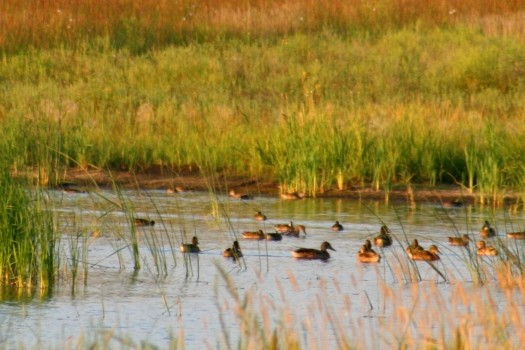Water makes up more than 70% of the Earth and about 60% of the human body. It’s no wonder that having clean water makes for a higher quality of life – for people and for wildlife. We at the U.S. Fish and Wildlife Service know that this is more than a conceptual ideal; we’re working with community partners and organizations to make it happen right now. Take a moment to learn about a recent U.S. Geological Survey-led water quality study that took place near Crookston, Minnesota.
“This study shows the value of natural areas and the legacy of Glacial Ridge,” said Ann Mulholland, who directs The Nature Conservancy’s work in Minnesota. “Protecting and restoring prairies and wetlands not only provides wildlife habitat and opportunities for outdoor recreation; it also provides clean drinking water and protection from flooding.”
Not far from Crookston, a town of roughly 8,000 people, is Glacial Ridge National Wildlife Refuge – the largest prairie-wetland restoration ever undertaken in U.S. history. With the help of land stewards, partners, volunteers, and funding through the U.S. Department of Agriculture Natural Resources Conservation Service, we worked with The Nature Conservancy to restore more than 20,000 acres that now make up the core of this rolling landscape. It’s been roughly two decades since biologists and land managers set about this herculean task. In 2002, researchers with the U.S. Geological Survey set out to see what value, if any, this restored native prairie-wetland brought to the landscape and the local residents who call northwestern Minnesota home.
The short answer is that, yes, native prairie and wetlands are good for water quality because they are the kidneys of the watershed. This collaborative study, a partnership of The Nature Conservancy, the state of Minnesota, and the team at the refuge, compared the complex hydrology before and after restoration. The investigators found substantial improvements in how water flows across restored habitats. This includes how rain and snow filter down through the robust root systems of native prairie plants and ultimately how excess water, known as ‘runoff,’ is less likely to carry nutrients off the landscape.
“Glacial Ridge continues to prove its worth to the local residents of Polk County and the Red River Valley landscape and ecology as a whole. The restoration of the prairie and wetlands provides improved water quality, a campaign that the state of Minnesota is still conducting to this day through local efforts,” said Nicole Bernd, district manager of the West Polk Soil and Water Conservation District.
The study found that a number of hydrological improvements at Glacial Ridge National Wildlife Refuge, all a result of the restoration work, led to a 33% decrease in the rate of water runoff. Lessening runoff helps more precipitation reach underground aquifers – Crookston’s primary source of drinking water. Less runoff also means a reduced chance of flooding and an increased certainty for the safety of surrounding croplands and public infrastructure.
“The City of Crookston has six high-capacity wells on or near Glacial Ridge. Having the refuge bordering the well fields ensures safe drinking water for years to come,” said Brandon Carlson, water superintendent for the City of Crookston.
The study found that the rate at which the surface water made it down to the aquifer, what’s known as “groundwater recharge,” increased by 14% post-restoration. Recharge is important because it helps maintain the amount of water stored in aquifers, which is used for drinking water and other purposes.
Another measure of the study is “ditch flow,” or amount of surface water that leaves the geography being studied. These restored habitats showed a reduction in ditch flow of 23%, which is a good thing for neighboring landowners downstream.
“Glacial Ridge National Wildlife Refuge has been a great asset to the City of Crookston and the surrounding area in multiple respects. The restorations that were completed have resulted in a significant reduction in both groundwater and ditch-water nitrate concentrations, which provides clean drinking water benefits for the area public,” said Gerald Jacobson, commissioner for Polk County.
The refuge isn’t only a great place to go birding and hunting; it’s making more clean water just by existing! Sometimes too much can be a bad thing, and that’s the case when it comes to water high in dissolved nitrogen and other nutrients. Although nitrates are essential for plant growth, too much can harm or kill aquatic animals like fish and affect the quality of lakes and streams where people paddle, fish, and swim. The study showed that these restored lands reduced groundwater nitrates by 79%! That’s making drinking water safer for everyone.
Funding for this project was provided by the Minnesota Environment and Natural Resources Trust Fund as recommended by the Legislative-Citizen Commission on Minnesota Resources. Come out to the refuge and discover your own connection to Glacial Ridge – excellent birding, beautiful tallgrass prairie flora, and quality hunting await!
Learn more about Glacial Ridge National Wildlife Refuge.




